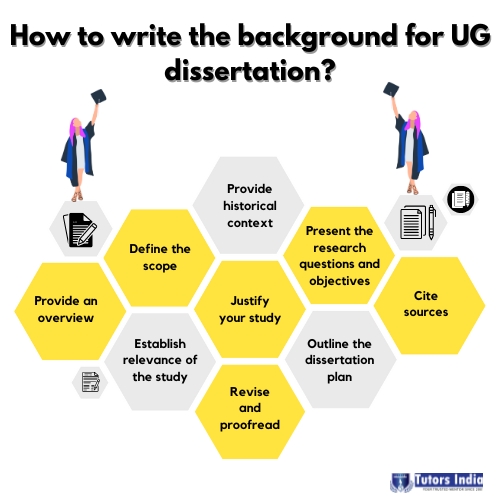How to write a good Background context for the UG dissertation?
What is the background of the research in a dissertation?
- The background of the research in a dissertation is a part of the introduction chapter of the dissertation. In some cases, the background is about 70% of the introduction.
- The background explains why the researcher was interested in a dissertation topic and how the research question was formulated.
- The background provides context for the dissertation, making it more reliable. The background of the research usually consists of the following:
- Relevant history of a specific problem,
- Areas explored in previously conducted studies, and
- Latest information about that problem
Why is the background of the research important?
- The background of the research helps engage the reader and understand the contribution of the researcher in a particular field. A research background helps set the scene for the readers.
- The background of the research makes the manuscript worthy of publication since it provides context (Roberts, 2018).
How to write the background of the research?
The following tips may help write the background of a UG dissertation:

- Provide an overview of the study
Begin writing the background of the research by providing an overview of the study. Highlight the main area of focus where you want to conduct the research. For instance, if a dissertation deals with employee stress and the productivity of a company, then start with what employee stress is, its impact, and how it affects the company.
- Define the scope
The background of the research must include the scope of the research. Specify what you intend to incorporate in your dissertation. This helps researchers understand the context of the research (Gunawan, 2017).
- Establish relevance
Explain why your research is important. Emphasise real-life implications, practical applications and any theoretical contributions made in the field. Discuss why the research helps fill a gap or helps address an issue that has not been adequately researched. In this section, include some significant statistics relating to the issue. Remember to cite the information, which helps bring credibility.
- Provide historical context
Provide a brief history of how the topic has evolved and has changed over time. Mention significant findings from previously conducted research by a literature review and how they have contributed to the current level of understanding. This historical viewpoint aids readers in understanding the progression of research in your discipline.
- Justify your study
Discuss why the research is necessary. Discuss how your research will help to close the identified gap, advance existing knowledge, or provide a new perspective. Highlight the potential impact, implications or practical applications of your research.
- Present the research questions and objectives
Introduce your research questions or objectives after providing the background context. The identified gaps and the broader context should be the basis of the research questions and objectives. Ensure that your research questions are clear, concise, and related to the primary objective of your research (Stappenbelt, 2019).
- Outline the dissertation plan
Finish the background section by briefly summarising the dissertation’s structure. Give a brief overview of the research objectives you will be addressing and the topics each upcoming chapter will cover.
- Cite sources
Ascertain that you properly cite all of the sources you use in your background context. This acknowledges previous studies and enables readers to look further into the sources.
- Revise for any errors
After you have written the background of the research, proofread and make the necessary revisions to ensure it’s clear, coherent, and grammatically correct. Check whether the background leads to the research questions and objectives. To make the necessary adjustments, get feedback from mentors or supervisors.
To know more about how a background for a dissertation is written, check out our dissertation example on Feature Images for recanalisation in acute ischaemic stroke.
What to avoid while writing a background for a UG dissertation?
- Loading the background with too much data. Doing so may confuse and lose the interest of the reader.
- Deviating from the topic and delving too much into previous research. Only the significant findings must be specified in the background.
- Discussing theories. Theories must be discussed in the literature review section.
- Lack of flow. The content must be presented in a chronological flow, which engages the readers.
- Repetition of the findings (Horowitz, 2013).
Conclusion
The background of the research is a crucial component of a dissertation, be it a UG dissertation, a Master’s dissertation or a PhD thesis. The background helps bring context to the dissertation and highlights the researcher’s contribution. The background of the research in a dissertation should begin with an overview, followed by defining the scope, establishing relevance, providing historical context, justification of the study, presenting the research questions and objectives, outlining the dissertation plan, and citing and editing for any errors. One must ensure the background is concise and coherent by avoiding repetition, discussing theories, loading the background with too much information and deviating from the topic.
About Tutors India
We are a team of experienced researchers and academic writers who offer dissertation help for Master’s and UG students. We assist with the full dissertation process, from selecting the dissertation topic, drafting a dissertation research proposal, writing a dissertation literature review, choosing the appropriate research methodology, data collection and dissertation statistical analysis. In addition, we also offer technical editing services and ensure the dissertation is error-free, plagiarism-free and abides by the university guidelines.
To learn more about how a dissertation is written in various fields, check out our dissertation examples.
References
- Roberts, L. D., & Seaman, K. (2018). Good undergraduate dissertation supervision: perspectives of supervisors and dissertation coordinators. International Journal for Academic Development, 23(1), 28-40.
- Gunawan, W., & Aziza, F. (2017). Theme and thematic progression of undergraduate thesis: Investigating meaning making in academic writing. Indonesian Journal of Applied Linguistics, 7(2), 413-424.
- Stappenbelt, B. & Basu, A. (2019). Student-supervisor-university expectation alignment in the undergraduate engineering thesis. Journal of Technology and Science Education, 9 (2), 199-216.
- Horowitz, J., Christopher, K.B. The Research Mentoring Program: Serving the Needs of Graduate and Undergraduate Researchers. Innov High Educ 38, 105–116 (2013).

 Previous Post
Previous Post Next Post
Next Post